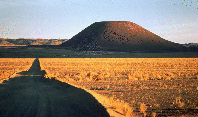Three Types of Volcanoes
Strato volcanoes are also called Composite volcanoes. They are very large, cone shaped mountains. Their eruptions are among the most violent, spewing out dangerous, very hot clouds of ash, gases, pieces of rock, some lava and causing mud flows called lahars. We have already seen pictures of Mt. St. Helens, a composite volcano. Here is another composite volcano - Mt. Fuji in Japan.
Thanks to Yamanashi Tourist Information for this picture.
Shield Volcanoes are different in that they are very spread out making a large base, they are slightly domed (like a Roman shield laying on its back) and are the main ones we see with lava flows. The lava usually travels slow enough that people have time to get out of the way. Thanks to PhotoBucket for this photo
Cinder Cone Volcanoes are the smallest of the 3 main types. It has very steep sides that are covered with the pieces of debris from the eruption - these pieces are called "cinders" - thus their name. These pieces are exploded into the air as magma, cool very quickly and fall within a relatively short distance.



Provided by Pacific Disaster Center Photo 2 and 3 from NASA's project ALERT
Exploring volcanoes <<<<CLICK HERE!!!!!
- Play time! Temperature, pressure and water are the three main "ingredients" that determine which type of explosion occurs. Here is a web site by Discovery Kids: Volcano Explorer that let's you choose the temperature and pressure conditions to see what type of volcano it produces - then watch the eruption! Click on the link below and after you "enter" the explorer look for the "Build your own volcano" button.
